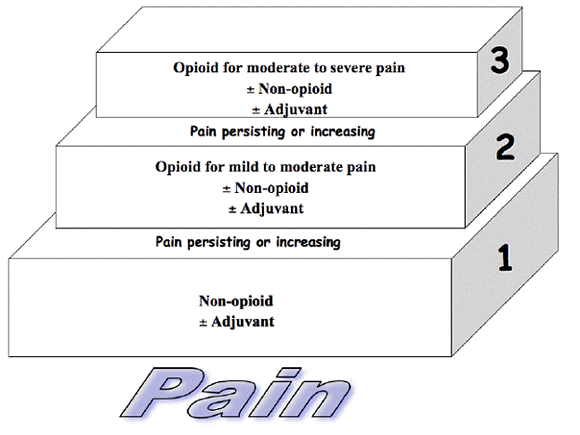Pain
Management
The World Health Organization’s pain ladder was created under the assumption that pain will increase as the child illness progress and this escalating pain should be matched with the introduction of stronger analgesics (6,7).
.
Figure 2: WHO three step analgesic ladder (8) Taken from Pain Management in Pediatric Palliative Care. Friedrichsdorf, Stefan J. MD. Children’s Project on Palliative/Hospice Services.
Step 1: Mild pain management.
- Non opioid analgesics such as acetaminophen or non steroidal anti-inflamatory drugs (NSAIDS) are used with or without adjuvants.
Step 2: Moderate pain management.
- Weak opioids as tramadol are added.
- Codeine is not recommended in pediatric analgesia (See Codeine)
Step 3: Severe pain management
- Strong opioids such as morphine, hydromorphone, oxycodone and fentanyl can be used.
Adjuvants
- The use of appropriate adjuvants should be considered at all levels of pain.
- Adjuvants are medications that are not usually prescribed for pain relief but in certain situations can offer analgesia.
- Some examples are:
- Anticonvulsivants and antidepressants for neuropathic pain.
- Nonsteroidal anti-inflammatory drugs for musculoskeletal pain.
- Anticholinergics for colic pain.
- Muscle relaxants for pain caused by muscle spasm.
The WHO provided some practical guidelines for children with cancer and these are summarized in four phases(8):
1. By the ladder:
- Enabling a stepwise approach to treatment commencing with non opioids and increasing to strong opioids.
- The level at which a child enters the ladder is determined by the child’s needs, the intensity of pain and response to previous treatments.
2. By the clock:
- Regular scheduling ensures a steady blood concentration, reducing the peaks and troughs of PRN dosing.
3. By the appropriate route:
- Use the least invasive route of administration. The oral route is the most convenient.
4. By the child:
- Individualize treatment according to the child’s pain and response to treatment.

